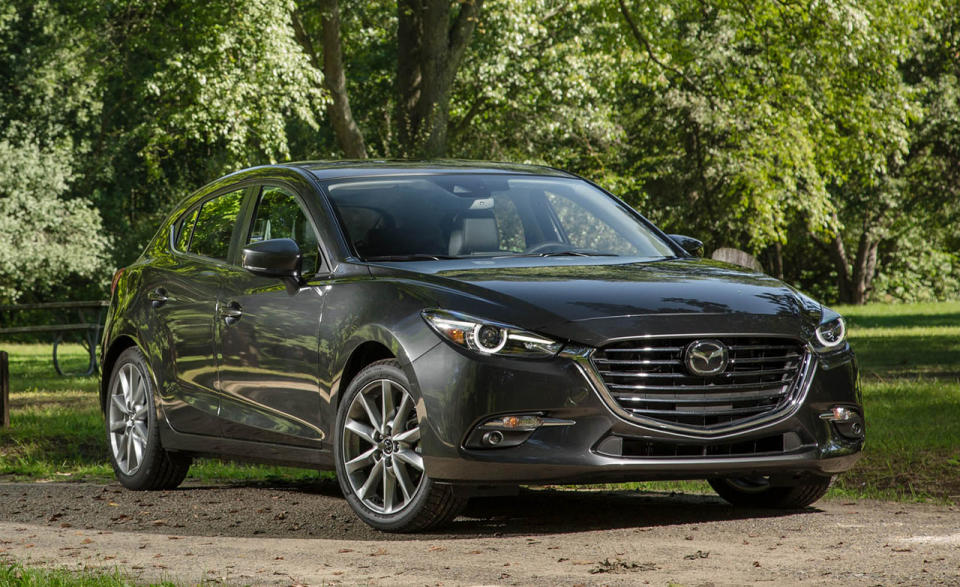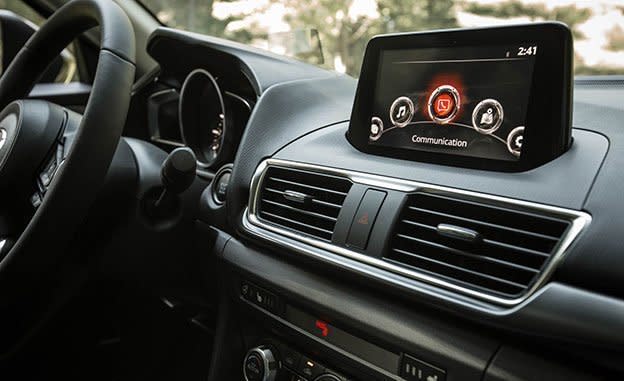2017 Mazda 3 2.5L Manual Hatchback

It starts with Aristotle—as so many things do—this idea that something can be more than the sum of its parts. Two people collaborating can build something better than two people working alone. A nimble chassis, a smooth ride, a silky transmission, and a responsive engine can make an objectively unexceptional car into a true joy, a fan favorite, a smart buy. It’s a strange alchemy, the process that makes several okay things into one great one, and we don’t pretend to fully understand it. But the good folks at Mazda sure do, and the refreshed Mazda 3 is proof.
Repackaged and Upgraded
Mazda has shuffled the 3’s lineup a bit for 2017, doing away with the confusing i and s trim designations, moving advanced safety content into cheaper models, fiddling with the front and rear bumper designs, and adding G-Vectoring Control. Mazda also tells us it worked to reduce noise in the cabin; our tests recorded 71 decibels at 70 mph in this vehicle, versus 72 decibels that we measured in a 2015 model with the same powertrain.

The 3 tested here was a top-of-the-line Grand Touring hatchback model fitted with the only engine available with that trim—a 2.5-liter naturally aspirated inline-four—and a six-speed manual transmission (a six-speed automatic is a $1050 option). A sedan can be had for $750 less, but we’d gladly pay the premium for the extra storage space and the easy-access liftgate. We think that the hatch simply looks better, too.
Our test car rang in at $28,030, handsomely equipped with the Grand Touring’s standard leather-trimmed interior, power seats, and 7.0-inch touchscreen infotainment display with redundant rotary controller. It also carried the $1600 Premium Equipment package (LED lighting, adaptive headlights, navigation, and a heated steering wheel) and the $1100 Active Safety package (lane-departure warning, lane-keeping assist, adaptive cruise control, and Mazda’s Smart Braking System, a form of automated-braking assist). Most automakers won’t let American buyers have these optional safety features with a manual transmission, preferring that the car be able to select gears on its own if, say, traffic conditions require the adaptive cruise control to slow it down from freeway speeds to a crawl. Mazda’s system, which operates between 18 and 99 mph, alerts the driver via a dashboard warning and chime to assume control and shift down to avoid stalling the engine in such circumstances.

The Mazda 3 has been one of our favorite cars for years, a staple on our 10Best Cars list and a much-beloved long-term test subject, so we don’t mind that little has changed about the driving experience. That’s not to say that Mazda hasn’t been hard at work, though. The company’s new G-Vectoring Control system is now standard in all Mazda 3s. It incrementally decreases engine torque when the driver initiates a turn, which increases load forces on the front tires to improve the car’s turn-in response and reduce the number of steering corrections needed to stay on track. It’s designed to operate undetected in the background, and that’s exactly what it does. Most drivers will notice only that the 3 feels nimble, with light but laser-accurate steering and a Vulcan-mind-meld-like understanding of the driver’s intent. It’s this attention to minor aspects of the driving experience that make Mazdas among our favorite cars at any price point.
Not-So-Awesome Numbers
You won’t find the truth about our fondness for this car in the performance numbers from our track test. The naturally aspirated engine offers linear acceleration and pairs so well with the smooth clutch and crisp gearbox that the 3’s lack of urgency off the line comes as a mild surprise. This one needed 7.4 seconds to accelerate from zero to 60 mph, only 0.1 second quicker than a Mazda 3 we tested last year with the base 2.0-liter engine and a six-speed manual. The 13.6 seconds this 3 took to accelerate from 30 to 50 mph in top gear (a test designed to replicate a passing maneuver without a downshift) was the slowest of any 2.5-liter stick-shift Mazda 3 we’ve tested—in the real world, the driver would ordinarily shift to a gear or two lower (as automatic transmissions do in this same test), but that doesn’t change the reality that this car was 2.1 seconds slower than our long-termer in performing the task.

The car didn’t distinguish itself in braking, either, needing a considerable 185 feet to stop from 70 mph, or 20 feet more than the long-term test car needed when it was similarly new. A Ford Focus SE EcoBoost we tested earlier this year needed only 173 feet, while a Volkswagen Golf TSI took just 168. Not many cars in the segment outperform the Mazda 3’s 0.84 g of grip on the skidpad, but many match it, so it can’t rightly be called the leader of the pack. The 3 returned 34 mpg on our 75-mph, 200-mile highway fuel-economy test, besting the EPA’s 33-mpg highway rating. With its smaller-displacement turbocharged engine, the 2016 VW Golf achieved 40 mpg in the same test.
The Mazda 3’s best qualities can’t be accounted for in braking distances or acceleration times. Instead, it’s the subjective elements that make the Mazda great: the obedience of the steering, the confidence-inspiring gearbox, the eager chassis, the upscale interior. All the controls feel balanced, delivering proportionate responses to equivalent efforts. This Mazda is the kind of car that brings out the best in the driver, even if it’s just on the daily commute. It’s so easy to drive well that it discourages lazy habits in favor of trying to perfect every shift and carve every corner.
Instead of giving us the quickest compact car, or the lightest, the most efficient, or the stickiest, Mazda simply gave us one of the best. And the company offers it with a standard six-speed manual, even in its top trim level and with all the modern technology. We’re sold. Still.
Specifications >
VEHICLE TYPE: front-engine, front-wheel-drive, 5-passenger, 4-door hatchback
PRICE AS TESTED: $28,030 (base price: $23,895)
ENGINE TYPE: DOHC 16-valve Atkinson-capable inline-4, aluminum block and head, direct fuel injection
Displacement: 152 cu in, 2488 cc
Power: 184 hp @ 5700 rpm
Torque: 185 lb-ft @ 3250 rpm
TRANSMISSION: 6-speed manual
DIMENSIONS:
Wheelbase: 106.3 in
Length: 175.6 in
Width: 70.7 in Height: 57.3 in
Passenger volume: 95 cu ft
Cargo volume: 20 cu ft
Curb weight: 3015 lb
C/D TEST RESULTS:
Zero to 60 mph: 7.4 sec
Zero to 100 mph: 19.4 sec
Zero to 120 mph: 32.5 sec
Rolling start, 5–60 mph: 8.1 sec
Top gear, 30–50 mph: 13.6 sec
Top gear, 50–70 mph: 12.4 sec
Standing ¼-mile: 15.7 sec @ 91 mph
Top speed (governor limited): 132 mph
Braking, 70–0 mph: 185 ft
Roadholding, 300-ft-dia skidpad: 0.84 g
FUEL ECONOMY:
EPA city/highway driving: 25/33 mpg
C/D observed 75-mph, 200-mile highway driving: 34 mpg
C/D observed highway range: 440 mi

 Yahoo Autos
Yahoo Autos 